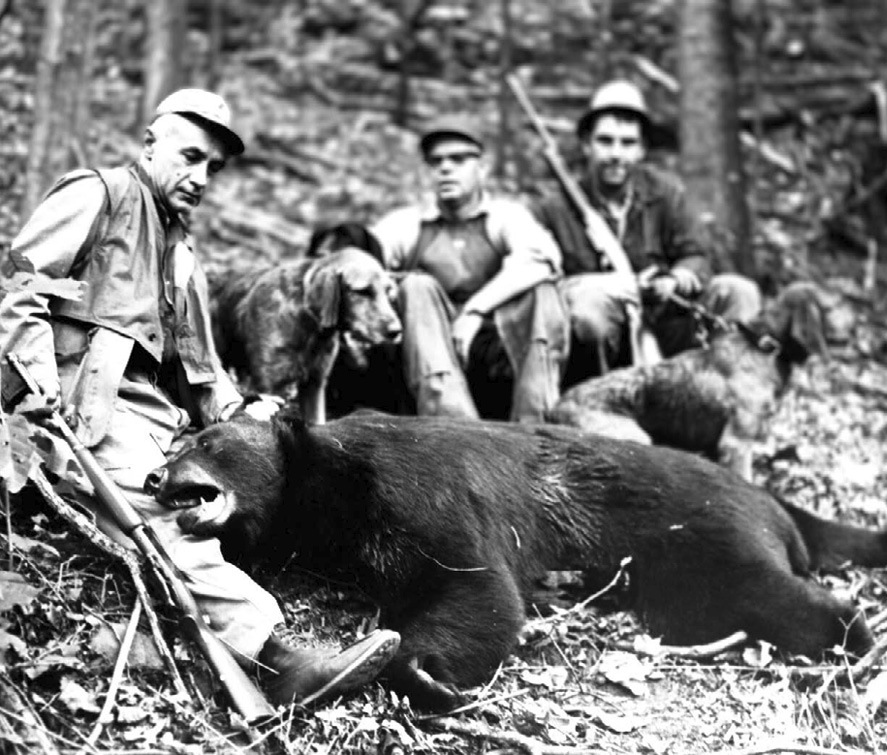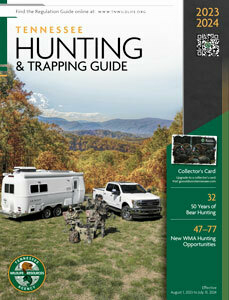Celebrating 50 Years of Bear Hunting

Black bear hunting is a time-honored tradition for many Tennesseans. Old-time bear hunters can recall the days when getting to run one bear per year was considered a good season, while now it’s common to run several bears each hunting trip.
While hunters have been chasing bears in Tennessee for well over a half-century, 2023 marks 50 years since the season was reopened after a three-year hiatus. Why was a break in hunting necessary? It’s hard to discuss bear hunting without a look into bear management, so let’s take a walk down memory lane.
Once found from Memphis to Mountain City, black bears were reduced to the remote mountainous areas of east Tennessee following the chestnut blight, land use changes, persecution, and unregulated harvest. Were it not for the creation of the Great Smoky Mountains National Park (GSMNP) and the Cherokee National Forest (CNF) in the 30s, bears might have been eradicated from the state. The establishment of the Tennessee Game and Fish Commission (TGFC) in 1949 created stricter hunting laws but the population was continuing to diminish. The earliest Tennessee bear harvest on record was in 1951 when hunters reported harvesting 29 bears, while the lowest recorded harvest was 7 bears in 1962. It’s been said that by the end of the decade, it’s believed there were as few as 50 bears within GSMNP borders. The TGFC closed bear hunting from 1970–1972 hoping the population would recover but when the season resumed in 1973, only 16 bears were harvested.
Where Are We Now?
These efforts have produced a continuously growing Tennessee black bear population now estimated at 6,500 individuals and a record harvest of 782 being taken in 2018. The GSMNP continues to harbor multitudes of black bears with a population estimated at 1,900 residing within the park’s 800 sq. mi. boundary. This equates to over two bears per square mile, one of the highest black bear densities in the world. Bears are protected inside the park, but the surplus population often leaves park boundaries providing hunting opportunities in surrounding areas. Hunting bears with hounds is the traditional method, but still-hunting has seen a recent surge with expanded archery hunting opportunities in new places including a transitional zone, as well as the Cumberland Plateau, making bear hunting legal in about 1/3 of the state. The Cumberland Plateau now boasts an estimated population of about 500 bears. While the harvest is low across most of this area, biologists say the population is growing 18–20% every year.
Headed West!
Bears aren’t just reserved for the mountains of East Tennessee anymore. TWRA has received reports of bears near Nashville and Memphis in recent years, which has certainly made news headlines. Will the population recover to the point that hunting seasons may be expanded further west? Time will only tell but either way, bear education will be a priority for TWRA. Our main focus as bears recolonize their former range is to educate the public on how to live responsibly with them. The fate of bears now will revolve around how humans deal with bear conflicts. It’s truly in all of our hands. Visit
A Three-Piece Puzzle
Today’s bear biologists credit a three-pronged approach to population recovery: 1) The need to reduce poaching, 2) The need to protect female bears and, 3) The need to provide sanctuaries. Bears are a shared resource prompting Tennessee, North Carolina, and Georgia to form the Tri-State Black Bear Study Group in 1976. The group continues to meet to discuss regional bear issues and has evolved into the Southern Appalachian Black Bear Study Group adding Kentucky, South Carolina, and Virginia. Their early work involved focusing on strategies to address the three-pronged approach.
To rectify poaching, “Operation Smoky,” the largest undercover bear-hunting sting in history, was carried out in Tennessee, North Carolina, and Georgia in the 80s. Forty-three individuals were charged with 130 state and federal violations involving poaching and the selling of bear parts. To better protect female bears, hunting seasons were moved later in the year to favor the harvest towards males as sow bears typically den earlier than boars. The third focus involved the establishment of black bear reserves within the CNF to provide source populations of breeding sows. Combining reserves with the Tennessee portion of the GSMNP equals over 450,000 acres where bears are protected in the state.


